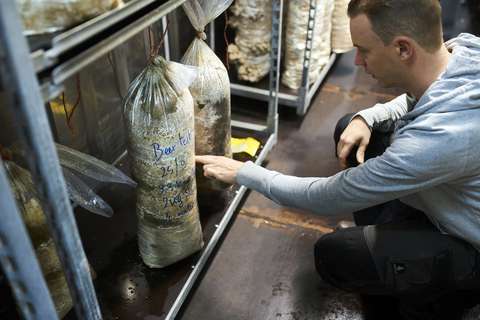In a circular economy, waste becomes raw material

An example of a regional circular economy was carried out in Kera by using mash, a by-product from beer production, for growing edible mushrooms.
An example of a regional circular economy was implemented in Kera last autumn by using mash, a by-product generated in beer production, for growing edible mushrooms. There are a lot of food production companies in the area, and one of them is Helsieni, which grows edible mushrooms based on the circular economy. In the experiment, which began in the autumn, Helsieni collaborated with breweries located in Kera to utilise the beer mash from beer production as part of the substrate for oyster mushrooms.
The aim of the experiment was to investigate the use of mash for growing oyster mushrooms and, if successful, to find local, practically neighbouring, raw material for circular-economy food production. Several breweries operate in Kera, generating beer mash as a by-product of beer production every week. The surplus mash from the breweries contains a lot of nutrients, which makes it an excellent raw material.
Local food in the circular economy
Helsieni usually uses straw pellets and coffee grounds from restaurants and hotels as a substrate for edible mushrooms. In the experiment, the company studied the use of mash as part of the mushroom substrate in several test batches where mash volume varied in relation to other raw materials. The experiment showed that mash spoils easily even if it is used immediately after the beer has been produced. Helsieni re-pasteurised the mash for the following batches, which reduced spoilage but did not completely prevent it.
The result of the experiment was that the use of mash would require even longer pasteurisation treatment and more work than the use of coffee grounds and straw pellets to produce a mushroom harvest. More mash is generated than Helsieni can use, so more operators would probably be needed to utilise all the raw material. Although the objective of the experiment to introduce a mash-based substrate was not achieved, it resulted in the development of regional material circulation and highlighted the need for comprehensive utilisation of bio-based waste generated in Kera, to the benefit of all parties, including financially. There is still room in Kera for a solution that would utilise bio-based waste generated by companies in the whole region.
In addition to the mash experiment, cooperation between companies located in Kera has been versatile – one example of this is Helsieni’s and Innogreen’s cooperation in the region. A mushroom bed developed from mycelium that had produced one harvest was made for Innogreen’s urban cultivation. By the end of the harvest, oyster mushroom seedlings grew there alongside strawberries.
The experiment was carried out as part of the Six City Strategy (6Aika) KIEPPI project. KIEPPI, short for Kestävien kaupunginosien kumppanuusmalli (Partnership model for sustainable neighbourhoods), is a project in which Tampere, Espoo and Turku develop new circular and sharing economy solutions for the urban environment in cooperation with companies and other partners.
Inquiries
Mia Johansson, KIEPPI Specialist, City of Espoo
mia.johansson@espoo.fi, tel. +358 40 5530439
Chris Holtslag, Founding Member, Helsieni
chris@helsieni.fi